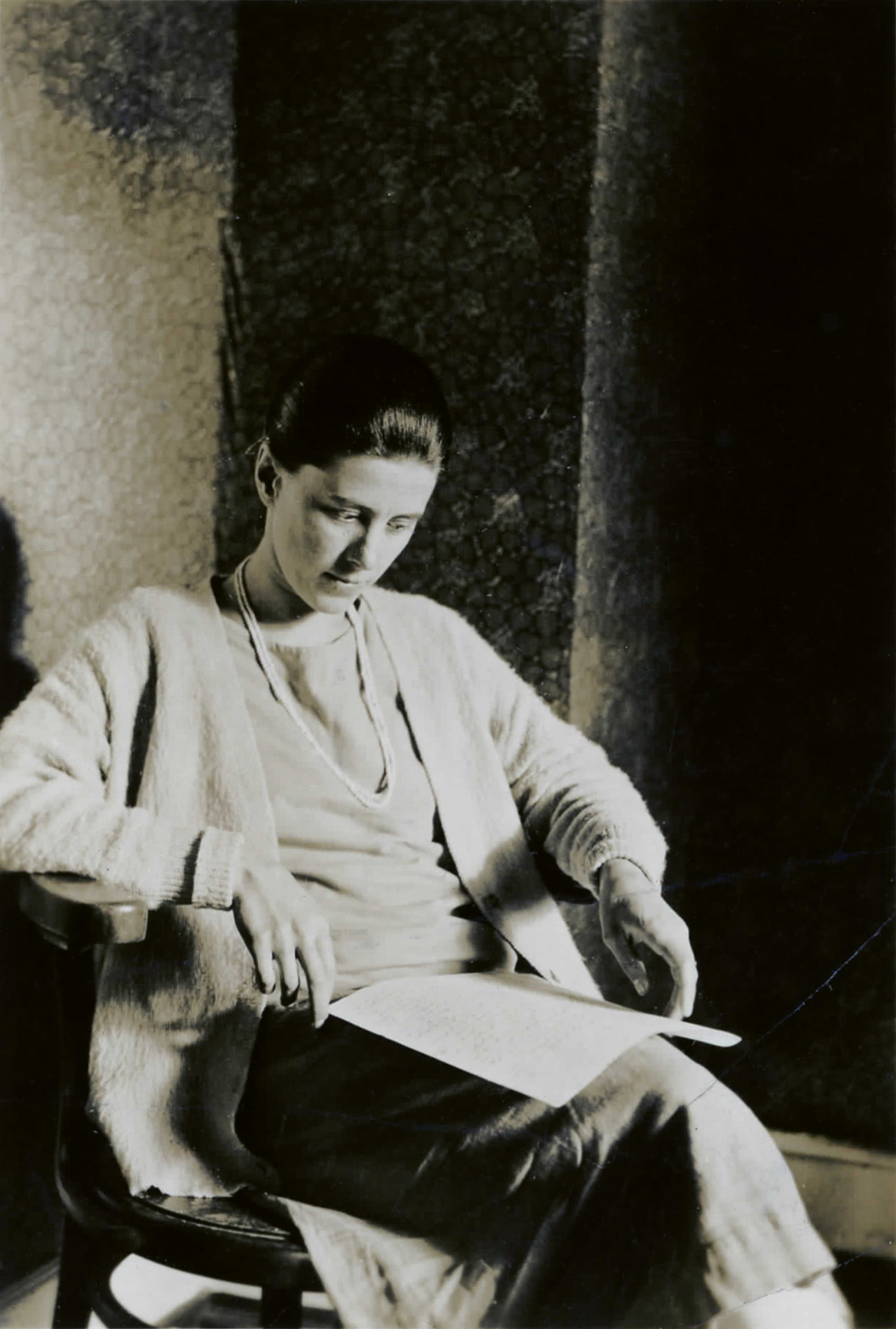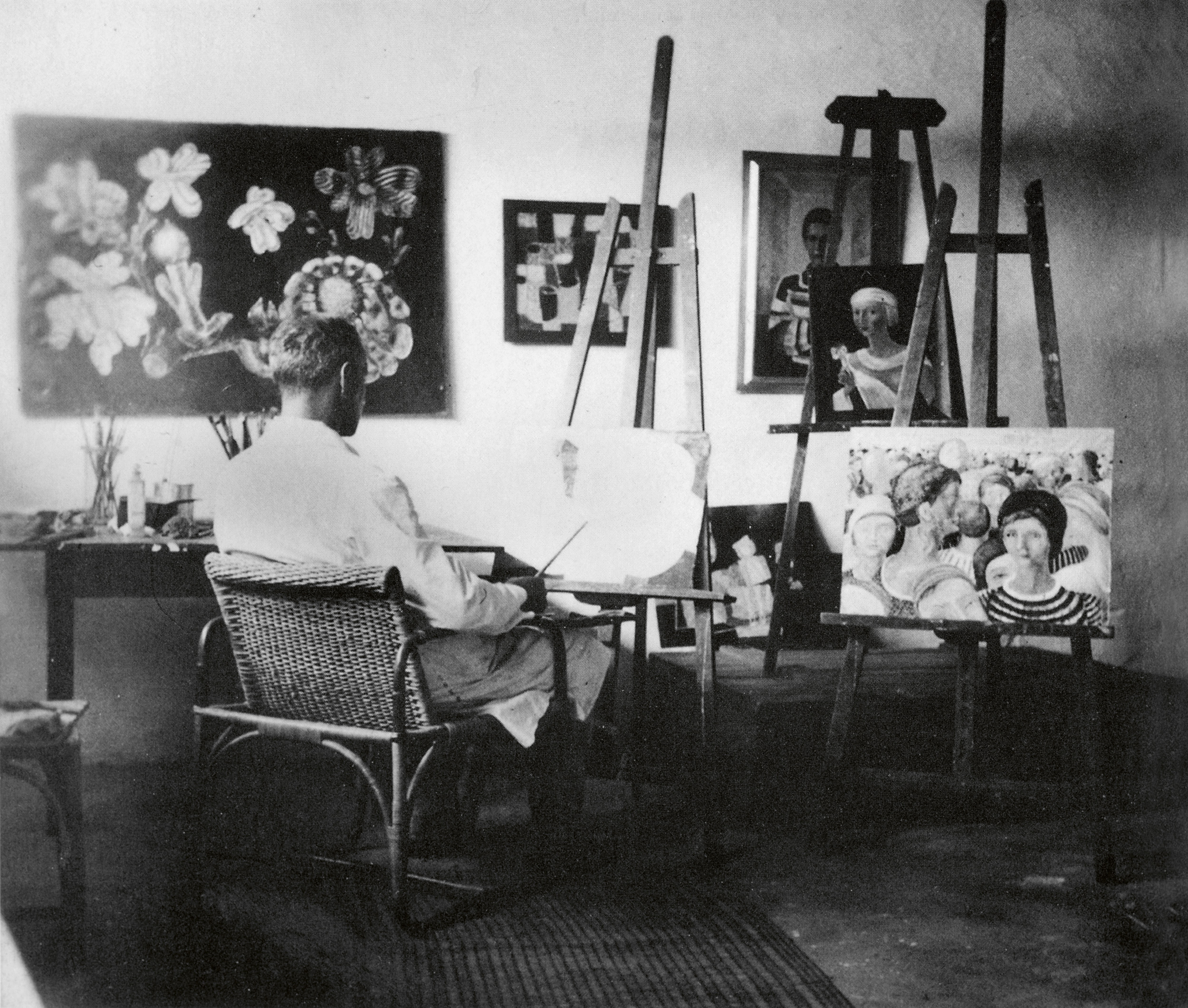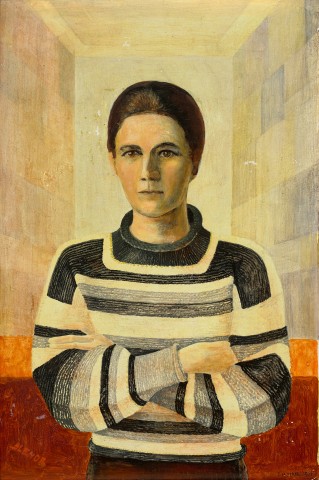PORTRAIT OF ELENOR, 1921
LUDWIG HIRSCHFELD-MACK
oil on cardboard
65.5 x 44.0 cm
signed and dated lower right: L. H. MACK 1921
inscribed lower left: ELENOR
accompanied by the original woollen jumper shown in the painting
The estate of the artist
Private collection, Italy
Schwarzbauer, R., and Bell, C., Ludwig Hirschfeld–Mack: More than a Bauhaus Artist, HistorySmiths, 2021, pl. 13, p. 186 (illus.)
230116 Portrait of Elenor cmyk.jpg

The arrival of Ludwig Hirschfeld-Mack in Australia in 1940 established a direct link between avant-garde European modernism and twentieth century Australian art. Interned in England, where he had sought refuge from the rise of Nazism in Germany, Hirschfeld-Mack was one of more than two and a half thousand men transported to Australia on board the HMT Dunera. Many of the ship’s passengers were highly educated, skilled professionals who went on to make significant contributions to the cultural, economic and social life of their new country. In the creative fields of art and design alone, the ‘Dunera Boys’, in addition to Hirschfeld-Mack, included the photographer Henry Talbot, the sculptor Erwin Fabian, and Fred Lowen and Ernst Rodeck, founders of FLER furniture.
Hirschfeld-Mack was one of the most well-trained artists on the Dunera. His studies began in 1913 when, with the support of a monthly allowance from his father, he enrolled at the Debschitz School in Munich, while undertaking compulsory military training.1 Progressive in its approach, the school welcomed female staff and students (including Hirschfeld-Mack’s sister, Emmy, who established a career in costume design), and encouraged the application of the visual and applied arts to everyday life.2 This approach aligned with the philosophy of the Bauhaus, where Hirschfeld-Mack continued his studies between 1919-25. Founded by architect Walter Gropius in Weimar in 1919, the Bauhaus counted among its teachers some of the most innovative and influential artists of the time, including Paul Klee, Josef Albers, Wassily Kandinsky and Oskar Schlemmer. Reflecting the idealism and desire for a better world which was shared by so many following the devastating experience of the First World War, the school’s manifesto proposed a radical and enlightened challenge: ‘Let us create a new guild of craftsmen, without the class distinctions which raise an arrogant barrier between craftsman and artist. Together let us conceive and create the new building of the future, which can embrace architecture and sculpture and painting in one unity’.3
Striking in its crisp modernity, this portrait of Hirschfeld-Mack’s wife, Elenor, was painted in 1921, four years after their marriage. Born in 1895, she was the eldest of three daughters of a successful patent lawyer and grew up in Frankfurt in an environment characterised by the privileges of wealth, including a country house built in the Art Nouveau style, replete with a large collection of art. At the age of seventeen, she attended school in England, developing her language skills and during the First World War, worked in Frankfurt’s main hospital, later receiving nursing qualifications and supporting the war effort in various medical facilities.4
The young couple met at a dance class and their marriage – which took place while Hirschfeld-Mack was on temporary leave from the army – was quickly followed by the birth of a daughter, Marga, in mid-1918. The family grew, with two more daughters, Ursel and Ellinor, being born in 1921 and 1928 respectively. Elenor was a devoted mother and while Hirschfeld-Mack described her as an ‘erstklassige Haushaltskönigin’ or ‘first-class queen of the household’, she also had an active life outside her domestic responsibilities. The Bauhaus years, with Oskar and Tut Schlemmer and Josef and Anni Albers among their closest friends, were particularly significant in this regard. The collegiate and creative atmosphere of the school inspired her to study art history and design, as well as to experiment with her own work in the weaving workshop.
Painted in oil on cardboard, the portrait describes Elenor’s appearance, as well as capturing something of her attitude and personality. Looking straight ahead and with arms folded in front of her body, she appears confident and purposeful, a modern twentieth-century woman. Her boldly patterned jumper, which was knitted by Elenor herself – has been retained by the family and accompanies the painting in this sale – is prominent within the picture and although Hirschfeld-Mack has paid attention to describing its texture, it is surely the graphic potential of the knitted bands of colour which most appealed to his artistic eye. While Elenor occupies a strangely compressed interior space, the focus is firmly on her image. The theme of geometric abstraction that Elenor’s jumper introduces to the composition continues however, in the background of the painting where delicately painted grids of pale, almost translucent colour adorn both side walls. It has been suggested that these patterns represent weaving designs which Elenor made in the Bauhaus workshops, but whatever their source, their presence here reminds us of Hirschfeld-Mack’s parallel interest in realism and abstraction and his ability to create images in both modes which combine strong visual design with a characteristically humanist motivation and intent.
dh230116 Painting (Sup Image) cmyk .jpg

The later years of Elenor’s life were hard. Multiple Sclerosis brought physical pain and movement became increasingly difficult. While she had fully supported Hirschfeld-Mack going to England when his Jewish heritage made it impossible for him to find full-time employment in Germany, the prospect of him ending up on the other side of the world was unimaginable. By the time travel between Europe and Australia was possible after the Second World War, her health was such that she was unable to make the journey to join her husband. They were reunited for a short time in late 1949 when Hirschfeld-Mack finally obtained permission to visit Elenor in the French zone of Germany. She died four years later.
1. For a detailed biographical account of Hirschfeld-Mack’s life, see Schwarzbauer, R. with Bell, C., Ludwig Hirschfeld-Mack: More Than a Bauhaus Artist, HistorySmiths, Melbourne, 2021
2. ibid., p. 23
3. Quoted in Schwarzbauer, ibid., pp. 36-37
4. All biographical information about Elenor Hirschfeld-Mack in this text is drawn from Schwarzbauer, ibid.
KIRSTY GRANT



